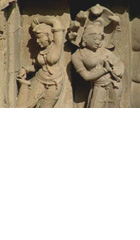
India: Khajuharo’s Ancient Temples 2003
Distributed by Chip Taylor Communications, 2 East View Drive, Derry, NH 03038-4812; 800-876-CHIP (2447)
Produced by Ashok Ojha
Directed by Sophia Ojha
VHS, color, 25 min.
College - Adult
Architecture, Art History, Art, Asian Studies
Date Entered: 04/07/2004
Reviewed by Geetha Yapa, Science Library, University of California, RiversideKhajuraho, a beautiful historical town situated in central India, is famous for its magnificent temples built more than a thousand years ago by Chandela kings. These temples represent some of the most exquisite architecture and sculpture of medieval India. However, they are most popularly known for erotic sculpture, which constitutes less than ten percent of the entire configuration. The documentary is based on research conducted by art historian and expert on Khajuharo, Dr. Devangane Desai. The primary intent of the film is to highlight the contributions made by Khajuharo to the world of ancient art. It also focuses on interpreting religious symbolism in order to correct the misrepresentations made by popular media and the tourist industry.
The film begins with historical information and legends associated with the origin of the temples. The viewer is then presented with architectural and sculptural details of the temples along with a closer view of the intricate details of carved imagery that decorate the temple walls. Dr. Desai provides detailed descriptions of icons found in two main temples with additional information about the sculpture. The narrator and Dr. Desai take turns describing the figures on the wall that depict all aspects of life ranging from deities and celestial maidens to animals and armies. Dr. Desai then moves onto her interpretation of erotic images and explains how art has been used to express philosophical theory. She traces prevalence of Tantric systems during the Chandela dynasty and highlights the importance of understanding the deeper religious meaning underlying the artwork.
The visuals include beautiful images of the temples and the surrounding village. Since the film focuses mainly on the sculpture found in two main temples and their interpretations, the viewer gets to see only a glimpse of the general layout of the temple system. The narrative is quite clear, but Dr. Desai’s explanations are abruptly cut short at times, which hampers the smooth flow of the documentary. The filmmaker has included Indian music and religious chanting between the narratives, adding a somewhat soothing effect. Although the distributor lists the title as India: Khajuharo’s Ancient Temples, the title on the tape is Khajuraho: Beyond Erotica.
Khajuraho: Beyond Erotica provides useful visual and factual information for those interested in Indian temple art and architecture. Recommended for college and adult collections in art history.
Additional information on this topic could be accessed from the following web sites:
Indiaprofile.com
Asian Historical Architecture